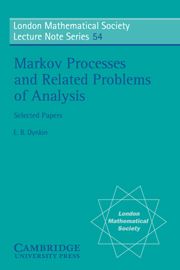Book contents
- Frontmatter
- Contents
- Preface
- I Markov processes and related problems of analysis (RMS 15:2 (1960) 1–21)
- II Martin boundaries and non-negative solutions of a boundary value problem with a directional derivative (RMS 19:5 (1964) 1–48)
- III Boundary theory of Markov processes (the discrete case) (RMS 24:2 (1969) 1–42)
- IV The initial and final behaviour of trajectories of Markov processes (RMS 26:4 (1971) 165–185)
- V Integral representation of excessive measures and excessive functions (RMS 27:1 (1972) 43–84
- VI Regular Markov processes (RMS 28:2 (1973) 33–64)
- VII Markov representations of stochastic systems (RMS 30:1 (1975) 65–104)
- VIII Sufficient statistics and extreme points (Ann. Prob. 6 (1978) 705–730)
- IX Minimal excessive measures and functions (Trans. AMS 258 (1980) 217–244)
VII - Markov representations of stochastic systems (RMS 30:1 (1975) 65–104)
Published online by Cambridge University Press: 18 March 2010
- Frontmatter
- Contents
- Preface
- I Markov processes and related problems of analysis (RMS 15:2 (1960) 1–21)
- II Martin boundaries and non-negative solutions of a boundary value problem with a directional derivative (RMS 19:5 (1964) 1–48)
- III Boundary theory of Markov processes (the discrete case) (RMS 24:2 (1969) 1–42)
- IV The initial and final behaviour of trajectories of Markov processes (RMS 26:4 (1971) 165–185)
- V Integral representation of excessive measures and excessive functions (RMS 27:1 (1972) 43–84
- VI Regular Markov processes (RMS 28:2 (1973) 33–64)
- VII Markov representations of stochastic systems (RMS 30:1 (1975) 65–104)
- VIII Sufficient statistics and extreme points (Ann. Prob. 6 (1978) 705–730)
- IX Minimal excessive measures and functions (Trans. AMS 258 (1980) 217–244)
Summary
A great deal of research into the theory of random processes is concerned with the problem of constructing a process that has certain properties of regularity of the trajectories and has the same finite-dimensional probability distribution as a given stochastic process xt. It is a complicated theory and one that is difficult to apply to those properties that we most need for the study of Markov processes (the strong Markov property, quasi-left-continuity, and the like.)
The problem can be usefully reformulated. In an actual experiment we do not observe the state xt at a fixed instant t, but rather events that occupy certain time intervals. This is the motivation behind the Gel'fand-Itô theory of generalized random processes. Kolmogorov, in 1972, proposed an even more general concept of a stochastic process as a system of σ-algebras ℱ(I) labelled by time intervals I. Developing this approach, we introduce the concept of a Markov representation xt of the stochastic system ℱ (I) and prove the existence of regular representations. We construct two dual regular representations (the right and the left), which we then combine into a single Markov process by two methods, the “vertical” and the “horizontal” method. We arrive at a general duality theory, which provides a natural framework for the fundamental results on entrance and exit spaces, excessive measures and functions, additive functionals, and others. The initial steps in the construction of this theory were taken in [6]. The note [5] deals with applications to additive functionals (detailed proofs are in preparation). We consider random processes defined in measurable spaces without any topology: the introduction of a reasonable topology allows of a certain arbitrariness.
- Type
- Chapter
- Information
- Markov Processes and Related Problems of Analysis , pp. 219 - 258Publisher: Cambridge University PressPrint publication year: 1982

